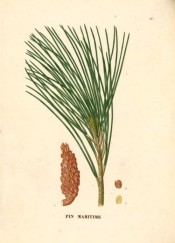Pinus pinaster Ait.
Fully-hardy, evergreen conical tree, becoming domed with age, with deeply fissured, orange to purple bark, paired, well-spaced, stout, grey-green leaves, to 25cm long, and narrow, oval female cones, to 22cm long, which ripen to chestnut brown. To 20m. Widely grown and sometimes naturalised in NSW. [RHSE, Hortus, Hilliers’, FNSW].
Horticultural & Botanical History
Cultivated in Europe since at least 1586 [JD], it is an important source of turpentine and resin. [Hilliers’]. ‘This is a beautiful tree, with much longer and brighter coloured leaves than the Scotch pine, and with larger cones arranged in clusters around the branches, and the scales ending in a rigid point. It grows best in deep loose soils, throwing down long tap roots that take hold even in the lightest soils, so that it can flourish even in the drifting sands of the sea-shore. Great use has been made of it in France in covering immense districts of barren sands. Around the Bay of Biscay large plantations of this pine have been formed to protect the land from the drifting sand which threatened to convert it into a desert. The downs around the Gulf of Gascony were at one time mere sandy wastes covering 300 square miles. Bremontier compared this immense surface to a sea which, when agitated to fury by a tempest of wind, overwhelmed everything in its neighbourhood. By sowing this tract of sand with the seeds of the pinaster mixed with those of the common broom, its whole nature has been changed. The seeds were sown behind rows of hurdles, and the broom, growing up quickly, protects the young pines from being rooted up or smothered by the sand. In 1811 a Commission appointed by the French Government made a report on the downs, and announced that about 12,500 acres of downs had been covered with thriving plantations, constituting the principal riches of the inhabitants, who are almost entirely supported by the preparation of resin and tar from the pinaster forests. Though the wood of the pinaster is soft and not of long duration, it is employed in the marine arsenal at Toulon for the outer cases of all the packages which are put on board vessels, and principally for the piles and props which are used for sustaining the frames of vessels while they are being constructed. In Bordeaux and in Provence it is employed for the common kinds of carpentry, for packing-boxes, and for fuel, but the most valuable purposes to which the tree is applied is the production of tar, resin, and lampblack. The manufacture and collecting of these substances forms a very active business in climates where the trees attain perfection. In Britain it would not be profitable to attempt it, as our summers are not sufficiently hot to produce the secretion in any quantity.’ [English Botany p.270 v.8/1868]. Saint-Hilaire Arb. pl.56/1824.
History at Camden Park
Listed in all published catalogues [C.68/1843].
Notes
Pinus pinaster Bess. (1801?) = Pinus laricio Poir.
See also Pinus halepensis Mill.
Published Jul 22, 2009 - 04:41 PM | Last updated Jul 29, 2010 - 03:27 PM
| Family | Pinaceae |
|---|---|
| Category | |
| Region of origin | Mediterranean |
| Synonyms |
|
| Common Name | Maritime pine, Cluster pine, Bournemouth pine |
| Name in the Camden Park Record | Pinus pinaster - cluster Pine |
| Confidence level | high |


